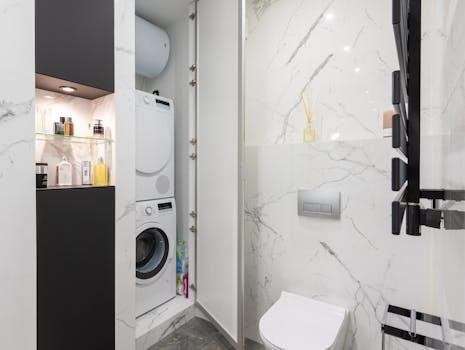
Toilet Bowl Light Instructions⁚ A Comprehensive Guide

Welcome! This guide provides detailed instructions for installing and maintaining your toilet bowl light. Whether you’re installing a Chunace, Vintar, OxyLED, or LumiLux model, we’ll cover essential steps. Follow these instructions for a seamless setup and optimal performance, ensuring safety and convenience.
Understanding Toilet Bowl Lights
Toilet bowl lights are convenient LED devices designed to illuminate your toilet bowl, offering a soft glow in the dark. These lights enhance safety during nighttime bathroom visits, preventing accidents and eliminating the need for harsh overhead lighting. They typically feature a flexible arm that attaches securely to the rim of any standard toilet bowl.
These lights are motion-activated, using sensors to detect movement within a specific range, usually around 5 meters with a 120-degree detection angle. Once activated, they provide illumination for a set duration, often around 120 seconds or 2 minutes, before automatically turning off to conserve battery life.
Many models offer a variety of color settings, including a carousel mode that cycles through multiple colors and a single-color mode where you can select your preferred hue. Understanding these features and functionalities is crucial for proper installation, operation, and maintenance of your toilet bowl light. These devices are easy to install and use.
Types of Toilet Bowl Lights
Toilet bowl lights come in various types, each offering unique features and functionalities. The most common types include basic single-color LED lights, which provide a steady glow in one selected color, enhancing visibility in the dark. Multi-color LED lights offer a range of color options, often with a carousel mode that cycles through different hues automatically.
Some advanced models feature customizable settings, allowing users to select and fix a single color or adjust the brightness level. Motion-activated lights are another popular type, using sensors to detect movement and automatically turn on the light, conserving battery life when not in use. Light-sensitive models only activate in low-light or darkness, further extending battery life.
Additionally, there are toilet bowl lights with aromatherapy diffusers, combining illumination with fragrance to create a pleasant bathroom environment. Understanding the different types available helps you choose a toilet bowl light that best suits your needs and preferences, ensuring both functionality and aesthetic appeal in your bathroom.
Preparing for Installation
Before installing your toilet bowl light, preparation is key to ensure a smooth and hassle-free process. Begin by unboxing the toilet bowl light and verifying that all components are present and undamaged, including the light fixture, flexible arm, and any included accessories. Ensure you have the correct type and quantity of batteries required, typically AAA or AA batteries, as they are often not included in the package.
Clean the rim of the toilet bowl where the light will be mounted to remove any dirt, grime, or residue that could interfere with the light’s secure attachment. Gather any necessary tools, such as a soft cloth for cleaning and possibly a small screwdriver if needed for opening the battery compartment. Read the user manual thoroughly to understand the specific installation instructions and safety precautions for your particular model.

Familiarize yourself with the light’s features, including the location of the sensor, color settings, and any adjustable options. By completing these preparatory steps, you’ll be well-equipped to install your toilet bowl light quickly and efficiently, ensuring it functions correctly and enhances your bathroom experience.
Battery Installation (AAA/AA)
Installing batteries correctly is crucial for the proper operation of your toilet bowl light. First, locate the battery compartment, usually on the back of the light unit. Use a small screwdriver if necessary to open the compartment, ensuring you don’t damage the casing. Identify the correct battery type required (either AAA or AA) as specified in the product manual or on the compartment itself.
Insert the batteries, paying close attention to the polarity markings (+ and -) inside the compartment. Align the positive (+) end of the battery with the corresponding mark and the negative (-) end with its mark. Incorrect polarity can prevent the light from functioning or even damage the device. Once the batteries are securely in place, close the battery compartment and ensure it is properly sealed.
Test the light by waving your hand near the sensor to confirm it activates. If the light doesn’t turn on, double-check the battery polarity and ensure the batteries are fresh. Replace the batteries if needed. Proper battery installation guarantees the toilet bowl light will illuminate correctly and provide the desired nighttime guidance.
Mounting the Light Fixture
Mounting the light fixture correctly is essential for optimal functionality and secure placement. Begin by carefully positioning the flexible arm around the rim of the toilet bowl. The light fixture should be oriented with the sensor facing outwards, allowing it to detect motion effectively. Ensure that the light’s body is positioned outside the bowl, while the LED diode is inside, providing illumination where needed.
Adjust the flexible arm to achieve a snug and secure fit, ensuring it rests firmly on the rim without being too tight or causing damage. The arm should be bent gently to conform to the shape of the bowl, providing stability and preventing the light from easily shifting or falling off. Double-check that the sensor has a clear, unobstructed view of the surrounding area to ensure reliable motion detection.
Once the light is mounted, test the sensor by moving around the bathroom to confirm it activates the light as expected. If the light doesn’t activate, readjust the fixture or check the sensor’s sensitivity settings. A correctly mounted light fixture will provide hands-free illumination and enhance your nighttime bathroom experience.

Adjusting the Flexible Arm
The flexible arm is a crucial component for securely attaching the toilet bowl light to the rim. Proper adjustment ensures the light stays in place and functions effectively; Start by gently bending the arm to match the contour of your toilet bowl’s rim. The goal is to achieve a snug fit that keeps the light stable without causing any damage.
When adjusting, make sure the arm isn’t bent too tightly, as excessive pressure can crack the plastic or compromise the light’s internal components. Conversely, if the arm is too loose, the light may wobble or fall off. Find the right balance by making small, incremental adjustments. Ensure the light’s sensor faces outward, allowing it to detect motion without obstruction.
Experiment with different positions along the rim to find the most secure and discreet placement. Once you’re satisfied, double-check that the light activates reliably when you enter the bathroom. A well-adjusted flexible arm will provide a stable and reliable lighting solution, enhancing your nighttime bathroom experience.
Sensor Activation and Range
Understanding the sensor activation and range is crucial for optimal performance of your toilet bowl light. These lights typically use motion sensors to detect movement and automatically illuminate the toilet bowl. Ensure the sensor is clean and free from obstructions for reliable activation. The sensor’s range determines how far away movement can be detected.
Most toilet bowl lights have a detection range of approximately 5 feet, covering a 120-degree angle. This means the light should activate when someone enters the bathroom or approaches the toilet. Positioning the light correctly is essential for maximizing the sensor’s effectiveness. Avoid placing the light where movement might be blocked by objects.
Test the sensor by walking around the bathroom to determine the optimal activation zone. Some models also feature light sensors, ensuring the light only activates in darkness to conserve battery life. If the light doesn’t activate consistently, try adjusting its position or replacing the batteries. Properly understanding and optimizing the sensor settings will ensure your toilet bowl light works efficiently and reliably.
Color Settings and Modes
Many toilet bowl lights come with various color settings and modes, enhancing both functionality and aesthetics. Understanding these settings allows you to customize the light to your preference. Most models offer a range of colors, including red, green, yellow, blue, and purple. Some even provide a carousel mode, automatically rotating through all available colors every few seconds.
To select a specific color, press the button on the device until your desired color is displayed. If you prefer a dynamic display, leave the light in carousel mode for a continuous color transition. Experiment with different colors to find what suits your mood and bathroom décor. Some lights also feature brightness adjustments, allowing you to dim or brighten the light as needed.
Different modes can include solid color, fading, or flashing options. The solid color mode maintains a single color, while fading mode gradually transitions between colors. Flashing mode, less common, provides a quick burst of light. By exploring these color settings and modes, you can create a personalized and enjoyable bathroom experience. Remember to consult the user manual for specific instructions on your model.

Troubleshooting Common Issues
Encountering problems with your toilet bowl light can be frustrating, but many issues have simple solutions. One common problem is the light staying on continuously or not turning off after the designated inactivity period. This could be due to a sensor malfunction or an obstruction near the sensor. Ensure nothing is blocking the sensor’s range and try cleaning the sensor lens.
If the light doesn’t turn on at all, check the batteries. Ensure they are correctly installed with the proper polarity and have sufficient charge. Replace the batteries if necessary. Another issue might be the flexible arm not fitting securely on the toilet bowl rim. Adjust the arm carefully to ensure a snug fit without excessive bending.
Inconsistent color display or flickering could indicate low battery power or a faulty LED. Replace the batteries first to rule out power issues. If problems persist, consult the manufacturer’s website or user manual for additional troubleshooting steps. For more complex issues, consider contacting customer support for assistance; Addressing these common problems can restore your toilet bowl light to optimal functionality.
Maintenance and Care
Proper maintenance and care are essential for prolonging the life and performance of your toilet bowl light. Regularly clean the light fixture with a soft, damp cloth to remove dust and grime. Avoid using harsh chemicals or abrasive cleaners, as these can damage the surface and sensor. Pay special attention to the sensor area, ensuring it remains free from obstructions for optimal motion detection.
Check the batteries periodically and replace them as needed to maintain consistent brightness and functionality. If you plan to leave the light unused for an extended period, remove the batteries to prevent corrosion and potential damage. Inspect the flexible arm regularly for any signs of wear or damage. Gently adjust the arm if it becomes loose or misaligned to ensure a secure fit on the toilet bowl rim.
Store the toilet bowl light in a dry and cool place when not in use to prevent moisture damage. By following these simple maintenance tips, you can keep your toilet bowl light in excellent condition and enjoy its benefits for years to come.